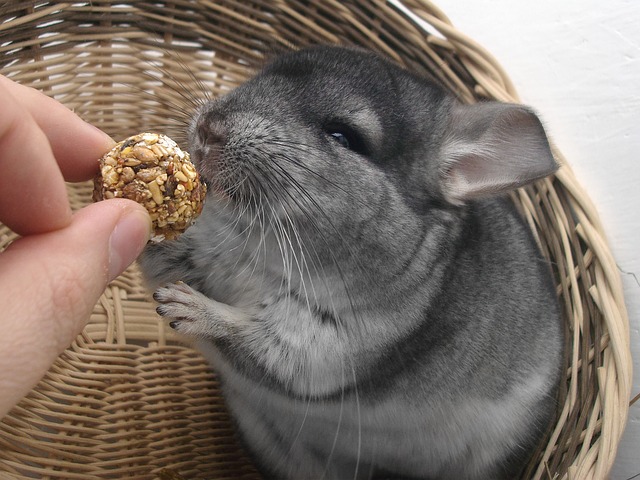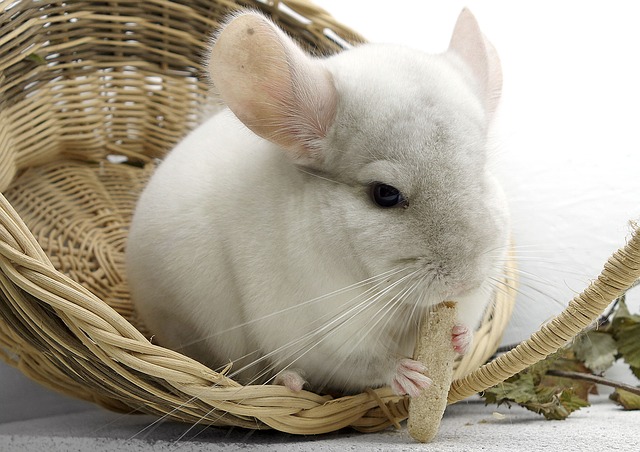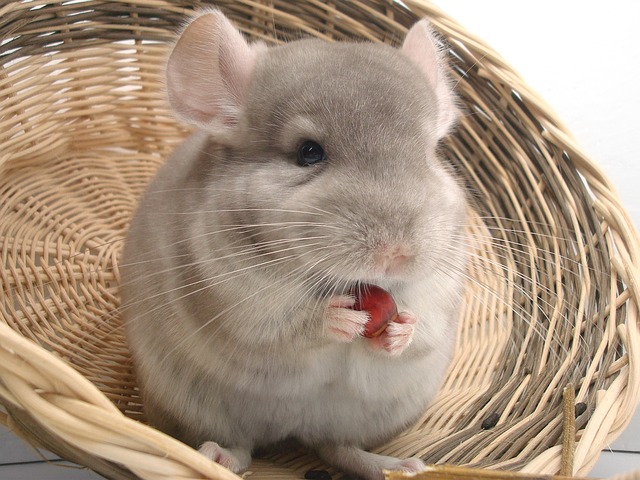
In the wild, chinchillas are a variety of grays. However, now that they are domesticated pets, colors are bred through the selection of desired traits. The different colors are called mutations.
The Basics
First, there are a few color mutations that are very common in the pet trade and easy to find. The standard grey is the most common and the color of chinchillas found in the wild. White chinchillas are fairly common, as are beige and ebony. All of these colors still belong to the same species – Chinchilla lanigera.
All of the color mutations make fantastic pets. There is no personality or care difference. The difference is in their appearance only – so it really is up to you what color you what (or what color needs to be rehomed or rescued). You can also house different colors together – I personally have standard greys and beiges living together.
Words and Definitions for Chinchilla Color Mutations
To understand the rest of this post you will need to review a few definitions. Genetics is complex topic, but for the sake of this post there are only a few basic terms.
Heterozygous – This means the chinchilla has two color genes that are each different. Example: dominant gene, A, and a recessive gene, a. This pair is Aa. The dominant gene is the one that fully shows in the fur color. The recessive gene can show up in the offspring of this chinchilla.
Homozygous – This means that a chinchilla has either two dominant genes or two recessive genes, either AA or aa.
Lethal Factor – Certain genes can’t exist in the homozygous (aa) state. There are two lethal genes for chinchilla colors. These are white and velvet/black. A white to white or velvet to velvet mating will result in fatality of any embryos.
Colors Chinchillas Come In
Originally, domesticated chinchillas were bred from Chinchilla lanigera or the long-tailed chinchilla as they are also known. Breeding the long-tailed chinchilla into the domestic pet, we know today produced the Standard Gray. This color is the original mutation from which we get all other chinchilla colors.
Breeders combine individual chinchillas with specific characteristics to produce different color mutations. The mutations are crossbred to create even more colors. As this happens, colors increase. There are up to 31 separate color mutations, but a lot of them are uncommon and expensive. The ones you are likely to run across are:
- Standard Grey
- Ebony
- White
- Homozygous Beige
- Heterozygous Beige
- Violet
- Sapphire
- Black Velvet
Standard Grey

Standard Gray is the natural color of wild chinchillas, and by far the most common in the pet trade. The color is a type of camouflage – since they live in rocky mountain areas they easily blend in with the rocks around them. Their main predators are birds, so from above it is difficult to pick out an adorable fluff ball amongst the rocks.
Their fur can be any shade of gray with crisp white bellies. Their color genes are the foundation of all other color mutations, ground zero if you will. Standard gray chinchillas are the cheapest to buy and easiest to find – but they still make amazing pets! My favorite chinchilla that I have ever owned was a standard grey, because it really is more about the personality of the chinchillas.
Ebony

Ebony first appeared in 1964. There are two versions of ebony but they are pretty comparable. Hetero Ebony chinchillas are black and dark gray with a light gray belly. So essentially they are like a really dark standard grey chinchilla. Homo Ebony (or Extra Dark Ebony) has a shiny black coat with no other colors, and their eyes are even black. They are beautiful, but expect to pay a lot if you are looking for a Homo Ebony.
White

White chinchillas are white with black or ruby eyes. The only color or shade difference is on their ears, which have a slightly darker hue. There are several variations of the white color. They are White Mosaic, Pink White, Wilson White, Silver, White Tan, and White Violet. The White Mosaic (or just Mosaic) chinchillas are the most common out of these.
White is an incomplete dominant gene – meaning that it blends or partially hide other genes. When mixed with Standard Gray, you get White Mosaic, Wilson White, or Silver. If combined with beige, you get what they call Pink White with patterns of beige.
This color is different because it should never be bred together. A white paired with another white results in a fatal mutation, meaning the kits are born disfigured, dead, or absorbed back into the mother’s body. Basically a miscarry due to a lethal gene combination. Damage to the mother’s reproductive organs can also occur, leaving her barren.
Heterozygous Beige or Tower Beige

Heterozygous Beige chinchilla is light beige along their sides, dark beige along their spine with a white belly with pink nose and feet. Their ears are pink and can be freckled.
Homozygous Beige
These chinchillas have red eyes and a lighter coat than the Hetero Beige. Apart from those differences, they are quite similar.
Violet
Violet chinchillas were discovered in Rhodesia, Africa, in the 1960s. These chinchillas have a gray coat with a purple tint with a white belly, black eyes, and pinkish-gray ears.
Sapphire
Sapphire chinchillas are light gray with a blue tint with a white belly and dark eyes. According to some people, these chinchillas are the hardest to breed and care for.
Black Velvet or Standard TOV
Black Velvet chinchillas have a coat that is black with gray sides, a crisp white belly, with dark eyes and ears. Their paws have dark stripes. This color cannot be bred to the same color as it is a lethal gene.
There are other colors that are not so common. I’ll list them but won’t go into any detail about them. They might be something you’ll want to investigate further if you are looking to buy or adopt a chinchilla.
- Blue Diamond Chinchilla
- Sapphire Chinchillas
- Wilson White Chinchilla
- Pastel Chinchilla
- Blue Chinchilla
- Fading White Chinchilla
- Black Pearl Chinchilla
- Mosiac Chinchilla
Wrap up
Now you know more about chinchilla colors and the genetics that create them! Two colors should never breed to the same color, unless they are standard greys. These genes can result in a lethal combination.
I hope this article has helped you understand the genetics of chinchilla colors. The main take away is that it doesn’t matter what color of chinchilla you have – they are all awesome! If you have any comments or questions, please leave one below.
